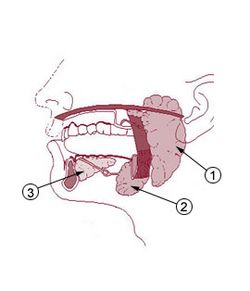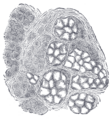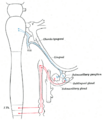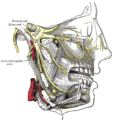Submandibular gland facts for kids
Quick facts for kids Submandibular gland |
|
|---|---|
 |
|
| Salivary glands: #1 is parotid gland, #2 is submandibular gland, #3 is sublingual gland | |
| Latin | glandula submandibularis |
| MeSH | Submandibular+Gland |
The submandibular glands are important salivary glands in your body. They are located under the bottom part of your jaw, near the back of your mouth. These glands work hard to produce saliva, which is also known as spit. Saliva plays a big role in keeping your mouth healthy and helping you digest your food.
Contents
What Are Salivary Glands?
Salivary glands are special organs that make saliva. Your body has three main pairs of these glands. The submandibular glands are one of these pairs. The other two pairs are the parotid glands (near your ears) and the sublingual glands (under your tongue). All these glands work together to keep your mouth moist and help with eating.
Where Are Submandibular Glands?
Your submandibular glands are shaped a bit like walnuts. You have one on each side of your face. They sit just inside the lower part of your jawbone, below your tongue. From these glands, small tubes called ducts carry the saliva into your mouth. The main duct for the submandibular gland opens up right under your tongue.
What Do Submandibular Glands Do?
The main job of the submandibular glands is to produce saliva. They make a mix of watery and thicker, mucus-like saliva. This mix is very important for several reasons:
- Digestion: Saliva helps break down food as soon as it enters your mouth. It contains enzymes that start the digestion process.
- Lubrication: Saliva keeps your mouth moist. This makes it easier to chew, swallow, and even speak clearly.
- Protection: Saliva helps clean your teeth and gums. It washes away food bits and can even help fight off germs that cause cavities.
- Taste: Saliva helps you taste your food by dissolving flavors so your taste buds can detect them.
Common Issues with Submandibular Glands
Sometimes, submandibular glands can have problems.
- Swelling: The glands might swell up if they get infected or if a salivary stone blocks a duct. Salivary stones are small, hard lumps that can form in the ducts.
- Infection: If bacteria get into the gland, it can cause an infection, leading to pain and swelling.
- Dry Mouth: If the glands don't produce enough saliva, you might experience a dry mouth. This can make it hard to eat and speak.
If you ever feel pain or swelling in your jaw area, it's a good idea to tell a grown-up. A doctor can help figure out what's going on and how to make it better.
Images for kids
See also
 In Spanish: Glándula submandibular para niños
In Spanish: Glándula submandibular para niños








